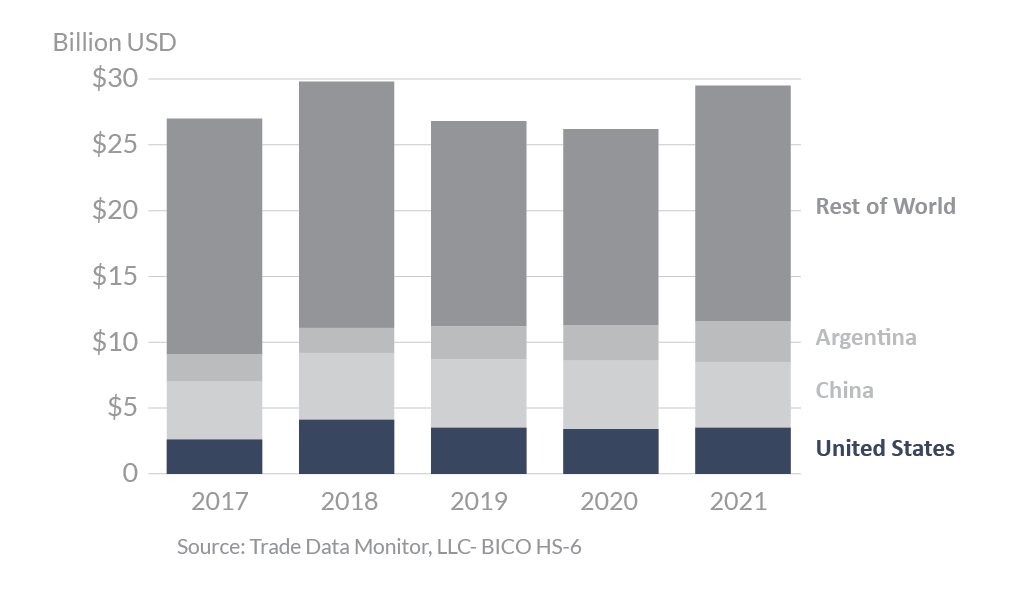
Vietnam 2021 Export Highlights
Top 10 U.S. Agricultural Exports to Vietnam(values in million USD) |
|||||||
| Commodity | 2017 | 2018 | 2019 | 2020 | 2021 | 2020-2021 % Change | 2017-2021 Average |
| Cotton | 1,056 | 1,312 | 1,428 | 1,161 | 1,026 | -12% | 1,197 |
| Soybeans | 288 | 469 | 273 | 425 | 395 | -7% | 370 |
| Distillers Grains | 58 | 264 | 257 | 284 | 361 | 27% | 245 |
| Dairy Products | 112 | 145 | 170 | 185 | 280 | 51% | 178 |
| Soybean Meal | 75 | 305 | 184 | 70 | 174 | 149% | 162 |
| Tree Nuts | 308 | 287 | 121 | 140 | 167 | 19% | 205 |
| Other Feeds, Meals & Fodders | 82 | 113 | 114 | 155 | 158 | 2% | 124 |
| Corn | 0 | 353 | 13 | 38 | 135 | 255% | 108 |
| Poultry Meat & Prods. (ex. eggs) | 76 | 110 | 140 | 128 | 101 | -21% | 111 |
| Fresh Fruit | 72 | 102 | 139 | 135 | 100 | -26% | 110 |
| All Others | 428 | 594 | 704 | 641 | 583 | -9% | 590 |
| Total Exported | 2,557 | 4,055 | 3,543 | 3,362 | 3,479 | 3% | 3,399 |
Source: U.S. Census Bureau Trade Data - BICO HS-10
Highlights
In 2021, Vietnam was the ninth-largest export destination for U.S. products, with exports totaling nearly $3.5 billion, a 3-percent increase over 2020. The United States is Vietnam’s second largest supplier of agricultural goods, generally representing around 12 percent of the total import market. China, the largest supplier, held around 17-percent market share. For many years, cotton has been the top U.S. product exported to Vietnam by a wide margin, remaining so in 2021 despite a decline from 2020. The largest year-to-year export increase was seen in soybean meal, an $104 million (149 percent) increase over 2020. Exports of corn, dairy products, and distillers’ grains also performed well, increasing by $97 million, $95 million, and $77 million, respectively. Commodities showing declines in 2021 included cotton, down $135 million, and fresh fruit, down $35 million. Vietnam was the 2nd-largest export destination for U.S. cotton and distillers’ grains, 10th largest for soybeans, and 8th largest for dairy products.
Drivers
- Vietnam’s GDP did not decline in 2020 due to COVID like many other countries, with growth of 2.9 percent in 2020 and projected growth of 2.3 percent in 2021. However, decreases in world clothing demand has negatively affected Vietnam’s purchases of U.S. cotton. This is significant, as cotton accounts for around a third of the total U.S. agricultural export value to Vietnam.
- Exports of U.S. dairy products were particularly strong in 2021 and have been growingly consistently in recent years. Much of the growth in 2021 can be attributed to increases in nonfat dry milk powder exports, followed by increases for whey and lactose.
- Vietnamese consumers continue to view U.S. food and agricultural products as safe and high quality.
- The travel and tourism sector, one of Vietnam’s most critical industries, hopes to benefit from the return of international visitors in mid-2022 after widespread COVID-19 disruptions since 2020.
- Vietnam’s agriculture sector continues to recover from an ASF outbreak, supply chain challenges due to COVID-19, and severe weather events due to climate change.
Vietnam’s Agricultural Suppliers

Looking Ahead
With a young, highly educated population and significant foreign direct investment, Vietnam is expected to recover quickly from the current global economic downturn. Relatively high tariffs and strong competition from countries benefitting from preferential trade agreements with Vietnam will constitute the most significant challenges to a diverse range of U.S. food and agricultural exports. Vietnam has numerous FTAs with third countries, including the Comprehensive and Progressive Agreement for Trans-Pacific Partnership, the European Union-Vietnam FTA, and the Regional Comprehensive Economic Partnership. Currently, the United States is subject to the higher most-favored-nation tariffs, while competitors from other markets, including the People’s Republic of China, Russia, Australia, Canada, New Zealand, and the EU, gain greater market share as tariffs decline under their FTAs.
U.S. raw materials that are inputs to Vietnam’s textile, manufacturing, and livestock sectors face zero or low tariffs, but have seen recent growth stymied by COVID-related restrictions. Vietnam’s demand for feed ingredients will continue to grow as the livestock sector benefits from an expected return of the food and hospitality sectors.
As a result of significant engagement, many agricultural trade irritants for the United States have been eliminated. Vietnam improved its meat and poultry facility registration process and restarted its approval process for biotechnology products. Vietnam also granted market access for U.S. sorghum, oranges, and blueberries. The United States continues to work on market access for U.S. grapefruit, lemons, mandarins, and stone fruit.
